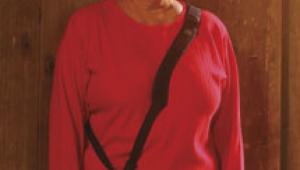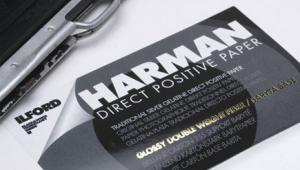photokina: “Out Of The Mainstream” Pro Cameras And Lenses: ...And A Sprinkling Of Inkjet Info
While a host of new digital cameras at photokina were covered in the January, 2013, issue of Shutterbug, this report focuses on some new out-of-the-mainstream cameras; new Zeiss and Schneider lenses designed to take advantage of ultrahigh-resolution sensors; and a couple of inkjet innovations that even I regarded as interesting. I say “even I” because I regard inkjet printing as being about as interesting as watching paint dry, which, after all, is what it is. Scanners will be covered under a future accessories report.
Alpa Cameras
Like previous 12-series Alpas, the new 12 FPS is distinctly out of the mainstream, though it is fully integrated into the Alpa family. It is specifically designed to work with digital backs, and has a lot of electronics on board. FPS stands for “Focal Plane Shutter,” so you can use just about any lens on it, old or new, though you will need shorter cones for existing Alpa-fit lenses in order to compensate for the extra thickness of the body. This camera is a dream for those who are searching for a unique look: I’d love to try it with vintage Tessars, for a start.

All Photos © Roger Hicks Ltd.
At first sight it looks awkward, a long, thin camera with the digital back at one end and the controls to one side, but when you pick it up you realize that again like other 12-series Alpas, it is brilliantly thought out and extraordinarily well balanced. It is so far from any other high-end digital camera on the market, owing almost nothing to “legacy” preconceptions about form and function, that it is hard to know where to begin describing it. All I can really say is that if you handle it, you’ll either “get it” immediately, or you won’t.
Cambo
There’s always a new Cambo Wide at photokina and in 2012 it was the very handsome RS5000 with its Alpa-style wooden handgrips and its apparently worm-drive lateral shift (22.5mm each way, for 45mm total) and rise/fall (25mm up, 15mm down, for 40mm in all). Adapters are available for Hasselblad, Mamiya Leaf, Phase One, and Sinar backs. Improbably, the accessory shoe is itself an accessory!
Arca-Swiss
Arca-Swiss refer to their Rm3d factum as “the world’s smallest technical camera with tilt and shift” and they are almost certainly right. It’s basically a focusing mount with +/- 15mm (30mm overall) of tilt or shift, and +/- 5 degrees of swing or tilt. These figures sound modest, but they are all you normally need. Inevitably, making something this small, light, and precise is, yes, you’ve guessed it, expensive. On the other hand, precisely because it’s not consumer oriented, it was the sort of thing I was tasked to look for at the show.

Mamiya Leaf
As George Schaub has already reported in January’s camera report, Leaf/Mamiya (the camera is available in both guises) made a number of mechanical and software improvements to their 645, but I wanted to mention the most brilliant leveling graphics I have ever seen. Imagine a goldfish bowl with a line around its equator, filled with blue-tinted water to the line. Tilt the bowl (the camera) left or right, and the “water level” stays level, but the line tilts. Tip it up or down, and the “water level” rises above the line (lens pointing downward) or falls below it (lens pointing upward). Simple, intuitive, effective: what more could you ask?
Sinar
Sinar’s eXact back offers a native 48 megapixels (8000x6000 on 48x36mm), but with 12 to 192 megapixels via “slugging” in one direction and extremely clever multi-sampling in the other. For multi-sampling, the sensor is physically shifted (via a piezoelectric “lever”) by one pixel in each direction, so the multi-sampled image is recorded sequentially on red, green, and blue pixels. It fits on Sinars and via adapters on Hasselblad H and V cameras, and on the Mamiya 645.

Rodenstock
Rodenstock brought out a new eShutter with remote control via iPod, iPad, and iPhone, and Rollei’s new electronic shutter seems to be very similar. Look for rapid expansion in the Rollei Hy6 system, now that they have sorted out (just before photokina) the trademark problems that had been bedeviling them.
Lenses
Both Zeiss and Schneider provided examples of an increasing trend toward fast, high-performance, manual focus D-SLR lenses designed to take maximum advantage of high-resolution, small-format sensors: Nikon and Canon are the mount options for both.
The aim, according to Dr. Nasse at Zeiss, is to replicate the effect of medium format in terms of both bokeh and depth of field; which, with a smaller format, necessarily implies working at larger apertures, but still with very high sharpness. It also argues for manual focus, as extremely precise focus is essential to get the maximum possible performance out of a lens, and the easiest way to get extremely precise focus is manually.

The problem is that making a fast, very sharp lens is expensive, so that (for example) the new 1.4/55 Zeiss is likely to cost over $6000. Although Schneider’s four new lenses, the 2.4/85 Makro-Symmar, 4.5/28 Super-Angulon Aspheric (with tilt and shift), 1.4/35 Xenon, and 1.4/50 Xenon, will not be in that class, they are not going to be cheap. If the way I’ve written speed and focal length look backward to you, well, that’s the way that both Zeiss and Schneider traditionally present them.
Two more super-high-performance Zeiss lenses are planned for the near future, but Dr. Nasse was cagey about what they might be, possibly because he did not want to give too much away to his rivals and possibly because Zeiss themselves are still keeping their options open. He did however indicate that there would most likely be one wider and one longer, so a fair guess would be a 28mm or 35mm and an 85mm or 100mm.

The 1.4/55 was very much a behind-the-scenes prototype, but we did get our hands on it, and it is BIG. Then again, contrary to one’s normal perception of fast lenses, it’s not really an out-and-about street lens, because camera shake would render all that resolution nugatory: handheld in low light, it might not offer much more resolution than the tiny, light Zeiss 1.5/50 C-Sonnar that increasingly lives on the front of my Leica M9. The 55mm focal length is also more suited to studio use than to street use, and besides, it’s easier to make a fast, sharp lens that’s a little longer than the usual 50mm.
Zeiss did however have their new 2/135 Apo-Sonnar on public display, for handling, again in manual focus, and very handsome it was. With 11 glasses in eight groups, it’s hardly a classic Sonnar layout, but it focuses to 1/4 life size. Although it was not as big, heavy, and expensive as the 1.4/55, it was still big and heavy and expensive. This may be a polarization we shall see more and more in D-SLR lenses: big, heavy, fast top-quality manual focus lenses to take advantage of high-end D-SLRs, and smaller, lighter, usually slower autofocus lenses for consumer use.

Then again, the market for manageably sized, reasonably affordable high-quality lenses may shift to smaller formats than 24x36mm. Again, both Zeiss and Schneider stepped into this market, Zeiss with a 1.8/32 Planar for APS-C sensors, shown on both Sony Alpha and Fuji X-Mount, with the promise of future lenses, while Schneider went for Micro Four Thirds with a 2/14 Super-Angulon (with four aspheric surfaces), a 1.4/30 “universal” Xenon, and a 2.4/60 Makro-Symmar. Don’t hold your breath, though: the first of Schneider’s lenses, the 2/14, is not scheduled for availability until the third quarter of 2013.

Schneider also presented a new range of lenses for video with full-frame Nikon or Canon D-SLRs: T2.1/75mm, T2.1/50mm, and T2.1/25mm. The 75mm should be the first available, from the first half of 2013.

A company I’d not heard of before, Cinematics, offered a range of (to quote their brochure) “High-Level Customized Film Lenses”: a range of full-frame lenses from 18/T3.5 to 100/T2 in EF, AI, PK, and PL mounts. Unfortunately, I was unable to get much information from the stand, which also had all kinds of other products on it, including a genuine micrometer-drive camera platform for macro work.

Finally, in out-of-the-mainstream lenses, Rodenstock offered a new HR Digaron-SW 90mm f/5.6: huge, heavy, and expensive, and without even as large an image circle as its nondigital predecessor. You can however guess why: this is yet another super-sharp lens designed to take maximum advantage of the ever-increasing resolution of digital backs.
Inkjet
Not so much an innovation, as a truly brilliant idea, was the “See Me, Feel Me, Print Me” stand showcasing papers from Canson, Hahnemühle, Ilford, Le Bon Image, Mitsubishi, Rauch, Sihl, and Tecco. The endless permutations of printers, software, papers, and printing media are very nearly as alchemical as the permutations of film, developer, enlarger, and paper in black-and-white photography. What suits one person won’t necessarily suit another, but equally, there is absolutely nothing to compare with actually seeing and comparing different prints. The stand also featured Fine Art Printer magazine, a German magazine whose title says all that needs to be said about its content—except, perhaps, that they don’t appear to deal with silver halide.
Two other new products intrigued me in my (admittedly hasty) glances at genuine inkjet innovations. One was a modestly-priced, environmentally-friendly continuous ink system from Image Alchemy, currently for Epson Stylus only but with other models planned. Continuous ink feed is more or less essential if you do much printing, just to keep the cost of the ink down: Image Alchemy reckons on a 90 percent savings, based on an initial fill. The really ingenious thing about this system is that it is genuinely continuous: you just keep topping up the ink tanks from squeezy bottles, so you don’t have the wasteful, time-consuming head-cleaning cycles every time you do (almost) anything. The design—software, hardware, inks (pigment and dye), everything—is the result of the sort of academic spin-offs that everyone keeps talking about, but you so seldom see: the address of the company is actually at Lancaster University in England.

The other innovation was at first sight one of the simplest, most old-fashioned products that you can readily imagine: varnish, in big, traditional paint cans. But making a varnish that will work with inkjet canvas media and fine art papers (though they say, always do a test first) is nothing like as easy as it sounds, especially when you want to offer it in three different finishes—gloss, satin, and matte. PermaPROtect comes from PermaJet, already well known for their inkjet canvases and papers and other digital products but also still a part of the same group as Nova Darkroom Products.
This is as good a place to stop as any. Not only is photography always photography, regardless of your chosen medium: art is always art, too. In France, private views at galleries (including photo galleries) are known as vernissages, literally, “varnishings,” because it was assumed that painters would be working on their paintings right up to the last minute, at which point they would varnish them to protect them. PermaPROtect opens the door for literal vernissages once more.

Contacts
Alpa: www.alpa.ch
Arca-Swiss: arcaswiss@aol.com (e-mail)
Cambo: www.cambo.com
Canson: www.cansoninfinity.com
Cinematics: www.pchood.com
Hahnemühle: www.hahnemuehle.com
HP Marketing (Rodenstock): www.hpmarketingcorp.com
Ilford: www.ilford.com
Image Alchemy: www.image-alchemy.com
Le Bon Image: www.bon-image.com
Mamiya Leaf: www.mamiyaleaf.com
Mitsubishi: www.mpm.co.jp
PermaJet: www.permajet.com
Rauch: www.rauch-papiere.de
Rolleiflex (DHW): www.dhw-fototechnik.de
Schneider: www.schneiderkreuznach.com
Sihl: www.sihl.com
Sinar: www.sinar.ch
Tecco: www.tecco.de
Zeiss: www.zeiss.com
Watch for more new product and innovation photokina coverage in future issues of Shutterbug.















































